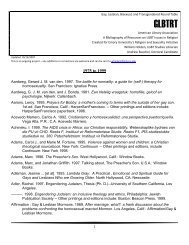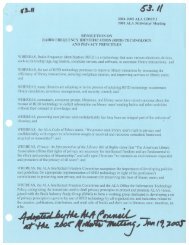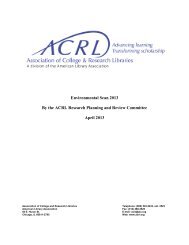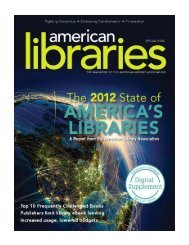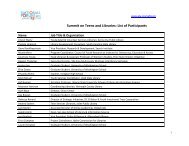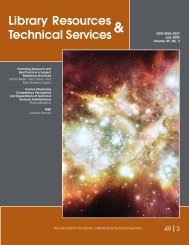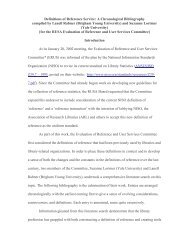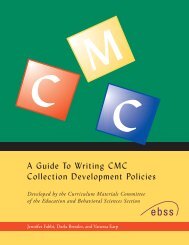The Campaign for America's Libraries - American Library Association
The Campaign for America's Libraries - American Library Association
The Campaign for America's Libraries - American Library Association
You also want an ePaper? Increase the reach of your titles
YUMPU automatically turns print PDFs into web optimized ePapers that Google loves.
An opinion column or letter to the editor can help to get your message be<strong>for</strong>e the public. Opinion columns<br />
generally run no more than 700 words and appear on the “op-ed” (opposite the editorial) page. When<br />
writing an op-ed, you will need:<br />
an attention-getting opening that states the problem;<br />
your key message and three key points that rein<strong>for</strong>ce it;<br />
statistics and examples—local/state/national—that illustrate your points;<br />
a close that summarizes and rein<strong>for</strong>ces your case.<br />
Letters to the editor are more succinct. Check the editorial/op-ed page of the newspaper or publication <strong>for</strong><br />
word length and other guidelines <strong>for</strong> submitting either a letter or opinion column. While you may draft<br />
the piece, it is often better to have it signed and submitted by a respected figure such as the university<br />
president, faculty member, or other ally.<br />
<strong>The</strong> opinion column below is intended <strong>for</strong> either a community newspaper or a campus publication <strong>for</strong><br />
parents or alumni. Be sure to read and edit it carefully. Or, draft your own column following the above<br />
guidelines. Be sure to include a name and contact in<strong>for</strong>mation, including title, address, telephone, and email.<br />
Most newspapers do not want columns longer than 750 words. <strong>The</strong> sample opinion piece in this<br />
toolkit is 575 words.<br />
Think Your Student Is Connected? Think Again<br />
Today’s college library is not what most parents remember. But then neither are most campuses. Thirty<br />
years ago, there were few co-ed dorms. No cash machines. No Starbucks. No Barnes & Noble. No<br />
computers.<br />
Like almost every other aspect of campus life, the library has evolved with the times.<br />
Today’s students take these changes <strong>for</strong> granted, of course. <strong>The</strong>y head to college armed with a cell phone,<br />
computer and modem, and think they’re connected. But unless they’ve connected with the library, they<br />
may not know what they’re missing.<br />
Here at [name of school], I see many students who have bought into the myth that the Internet is all they<br />
need. Indeed they may have succeeded in their high school studies with little more. Unlike their parents,<br />
whose elementary and secondary education routinely included orientation in library use and research<br />
techniques, the focus <strong>for</strong> many of today’s students is on learning to use a computer and navigate the<br />
Internet—critical skills, but far from the only ones needed to succeed in college and throughout their<br />
lives.<br />
What many students—and parents—don’t realize is that today’s college library offers the best of both<br />
worlds. It has resources on- and offline that the Internet will never offer. At our library, these include<br />
[highlight collections of special interest]. Some resources—such as [specify]—are used by researchers<br />
around the world.<br />
<strong>The</strong> library’s online collections include back issues of newspapers and magazines, abstracts and scholarly<br />
journals, encyclopedias, and many specialized databases selected by librarians. <strong>The</strong>se resources carry<br />
price tags that most students and researchers could never af<strong>for</strong>d.<br />
30



